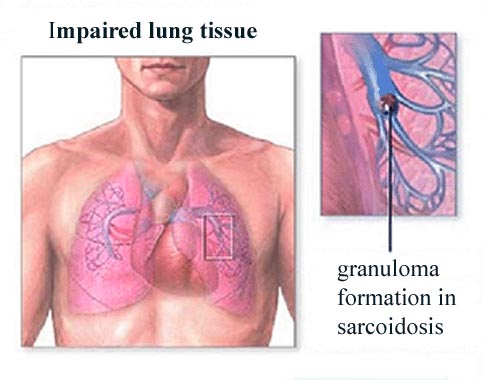Sarcoidosis
Sarcoidosis is a disease that results from a specific type of inflammation of tissues of the body. Chronic multisystem disease of unknown etiology, commonly affecting the lungs, skin, and eyes, characterized by formation of noncaseating granulomas. Has a bimodal age distribution with 2 peaks in the third and fifth decades. It can appear in almost any body organ, but it starts most often in the lungs or lymph nodes. The cause of sarcoidosis is unknown. The disease can appear suddenly and disappear. Or it can develop gradually and go on to produce symptoms that come and go, sometimes for a lifetime. As sarcoidosis progresses, microscopic lumps of a specific form of inflammation, called granulomas, appear in the affected tissues. In the majority of cases, these granulomas clear up, either with or without treatment. In the few cases where the granulomas do not heal and disappear, the tissues tend to remain inflamed and become scarred (fibrotic). Sarcoidosis was first identified over 100 years ago by two dermatologists working independently, Dr. Jonathan Hutchinson in England and Dr. Caesar Boeck in Norway. Sarcoidosis was originally called Hutchinson's disease or Boeck's disease. Dr. Boeck went on to fashion today's name for the disease from the Greek words "sark" and "oid," meaning flesh-like. The term describes the skin eruptions that are frequently caused by the illness. Lungs and lymph nodes affected in >90% of patients. Treated with topical corticosteroids for mild local cutaneous disease. Systemic corticosteroids are the mainstay of treatment for severe disease. Carries a mortality of 1% to 6%. Poorer prognosis if black ancestry, chronic pulmonary involvement, lupus pernio, or chronic hypercalcemia. Spontaneous remissions occur in 55% to 90% of patients with stage I, 40% to 70% of patients with stage II, and about 20% of patients with stage III disease, but no remissions are expected in stage IV.
